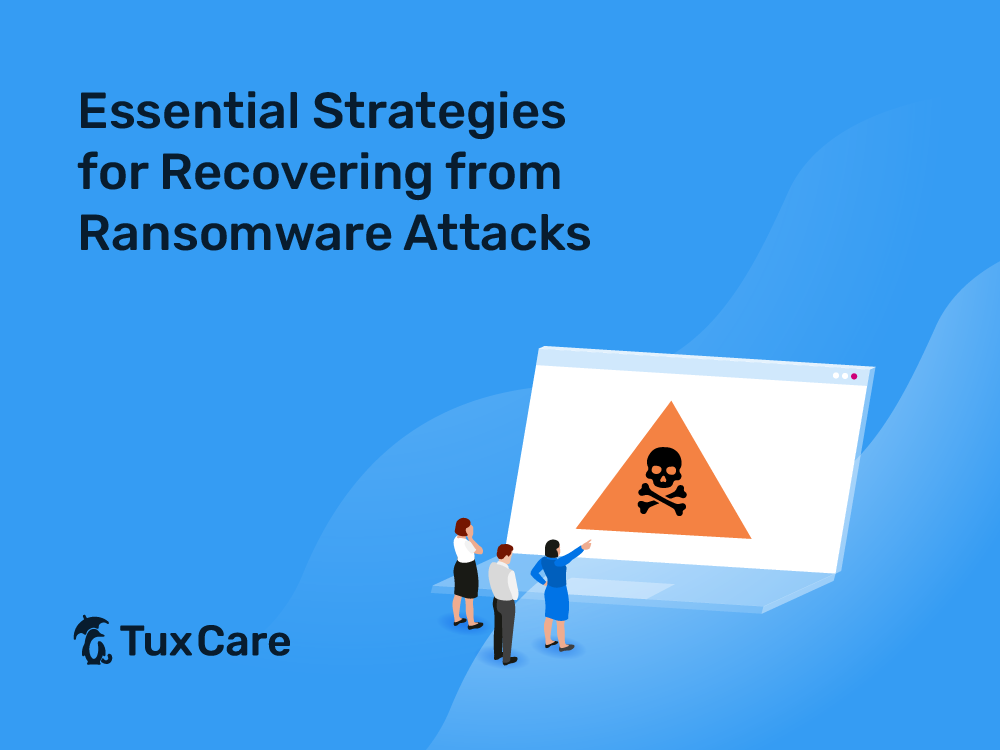Essential Strategies for Recovering from Ransomware Attacks
- Ransomware is a serious threat, so be prepared!
- The average ransom demand is high, and paying doesn’t guarantee recovery.
- Backups are crucial for recovery, but testing and proper storage are essential.
Ransomware attacks have become a significant threat to organizations of all sizes, and these malicious attacks can encrypt sensitive data, disrupt operations, and demand hefty ransom payments – leaving businesses scrambling to recover. However, with the right strategies and protocols in place, organizations can effectively recover from such attacks and minimize the damage incurred.
This guide will equip you with the essential steps to navigate a ransomware attack, minimize damage, and ensure business continuity.
What are Ransomware Attacks?
Ransomware is a type of malware that encrypts files or systems and prevents access to them until a ransom is paid to attackers. Attackers demand a payment, usually in cryptocurrency, in exchange for a decryption key. The primary goal of ransomware attacks is to extort money from individuals, businesses, or organizations by denying them access to their own data or systems.
Ransomware can enter a system through phishing emails, malicious attachments, compromised websites, or exploiting vulnerabilities in software or operating systems. Once inside a system, the ransomware encrypts files, rendering them inaccessible to the user or organization. The attackers then display a ransom note, informing the victim of the encryption and providing instructions on how to make the payment to receive the decryption key.
Ransomware Cases in 2024
Ransomware attacks saw a massive spike in 2023, with a concerning 55.5% increase in victims globally, totaling 5,070 cases. Construction, healthcare, IT, and financial services were the most impacted sectors in 2023. However, the trend has shifted in 2024. Despite a spike to 1,309 cases in Q4 2023, Q1 2024 witnessed a decline to 1,048 cases, marking a significant 22% decrease in attacks compared to the previous quarter. (TheHackerNews)
Some of the major organizations targeted in 2024 so far include:
- Kansas City Public Transportation
- Crinetics Pharmaceuticals
- UnitedHealthcare
- Hyundai Europe
- LoanDepot
Lockbit emerged as the top ransomware threat to businesses in 2023. Although its ransomware infrastructure was dismantled in February 2024, the ransomware group has returned with new infrastructure.
Don’t Pay the Ransom
Ransomware attacks can be a nightmare. You risk losing crucial data, facing financial losses, and experiencing business downtime. Additionally, some ransomware steals sensitive information and threatens to expose it publicly if you don’t pay, adding to the pressure.
Despite the potential consequences, some victims may choose to pay the ransom in the hopes of regaining access to their data or avoiding further damage. However, there’s no guarantee that paying the ransom will get you the decryption key. Hackers may disappear with your money, or the key they provide might not work. Paying a ransom only fuels the cybercrime industry. It incentivizes criminals to continue targeting businesses, knowing they can profit. Paying a ransom can make you a target again. Hackers may see you as a reliable source of income and attack you repeatedly.
If the data is absolutely essential, for example, involving life-saving medical information, and you have no backups, then considering payment might be an option. This should only be considered after thoroughly exploring all recovery options, including data decryption tools and professional recovery services.
Recovering from Ransomware Attacks
Initial Response: Assess and Isolate
The first step in recovering from a ransomware attack is to assess the situation thoroughly. This involves identifying the extent of the attack and determining which systems and data have been compromised. If possible, try to understand the ransomware variant involved. If you identify the ransomware variant, you can use information about its typical file extensions. This can help you uncover additional infected files on your system, even if they haven’t yet displayed the ransomware message.
Another actionable task you can do is to immediately isolate infected devices to prevent the ransomware from spreading across your network, such as disconnecting them from the internet and internal networks.
Communication Is the Key
Effective communication is critical during a ransomware attack for several reasons:
Maintaining Trust: A malicious attack can be a time of fear and uncertainty for everyone involved. Clear, transparent communication from the organization helps maintain trust with stakeholders, including employees, customers, and partners.
Managing Public Perception: In some cases, the attack incident may become public knowledge. Owning the situation and demonstrating a commitment to resolving it builds public trust. Communicate that you’re working diligently to resolve the issue. Use a clear and concise message on a public-facing website or social media account, such as “We are currently experiencing technical difficulties and are working to restore full functionality. We appreciate your patience.”
Legal Compliance: Depending on the nature of the attack and the data involved, there may be legal requirements for notifying customers or law enforcement. Clear communication protocols ensure compliance with these regulations and avoid any legal complications.
Dependency Schematics
During a ransomware attack, when your systems are down and time is critical, understanding how everything fits together becomes crucial. This is where having dependency schematics readily available proves invaluable.
A dependency schematic is essentially a roadmap that visually depicts the relationships between your various IT systems. It shows how different components interact and depend on each other to function. By understanding which systems rely on others, you can prioritize recovery efforts. This helps you get critical systems back online faster, minimizing downtime and impact on your business.
Planning and Response
Develop a comprehensive recovery plan outlining the steps to be taken to minimize damage and bounce back quickly. Here are some key steps to include:
- Isolate infected systems to prevent further spread of the ransomware.
- If you have backup files, initiate data recovery from your backups. This is why having a tested and secure backup strategy is crucial!
- Don’t hesitate to involve law enforcement and cybersecurity professionals for assistance. Their expertise can be invaluable in containing the attack and potentially recovering data.
Backups are Lifelines
Having backups in place is a critical step in protecting yourself from ransomware attacks. These backups allow you to restore your data in case it gets encrypted by ransomware. However, simply having backups isn’t enough. You also need to ensure they actually work when you need them most.
Imagine a scenario where you’re hit by ransomware and attempt to recover your data from backups, only to discover the backups are corrupted or incomplete. This can be a devastating situation. Testing your backups regularly helps identify any issues and ensures they can be restored successfully.
Testing your backups doesn’t have to be a complex process. You can create a small test dataset (like a new document) and try restoring it from your backup. Regularly scheduling these tests (perhaps weekly) helps ensure your backups remain functional.
Securing Your Backups
Just as important as testing is securing your backups. Ransomware can target backups stored on the same system as your main data. To prevent this:
Separate Storage: Never store backups on your main system. Use a separate storage device, ideally one with an “air gap” meaning it’s not constantly connected to your network.
Removable Media: Alternatively, consider using removable media like external hard drives for backups. This allows you to physically disconnect them after the backup process, providing an extra layer of security.
Prevention is Paramount
Prevention is always better than cure when it comes to ransomware attacks. Following proactive measures can be considered to reduce the risk of future incidents:
- Implement robust cybersecurity measures, including firewalls, antivirus software, and intrusion detection systems.
- Educate employees about ransomware threats and best practices for cybersecurity hygiene, such as avoiding suspicious links, email attachments, and other social engineering techniques. A recent case of the Las Vegas Casino attack can be taken as an example, where attackers impersonated a contractor, tricking the support personnel into providing access.
- Regularly update software and systems to patch known vulnerabilities and strengthen defenses against emerging threats.
- Consider investing in advanced threat detection technologies, such as behavior-based analytics and endpoint protection solutions.
Final Thoughts
Recovering from a ransomware attack requires a coordinated and proactive approach, encompassing assessment, communication, planning, response, data recovery, and preventative measures. Once you’ve recovered your data, prioritize resetting system configurations, including settings and registry entries, that the attackers might have tampered with. Also, do not forget to document everything! Details about the attack and your response will be invaluable for future incidents. This knowledge can help you identify patterns and improve your response strategy.
By implementing stronger security measures like updating software, patching vulnerabilities, and educating employees about cyber hygiene, organizations can minimize the potential risk and safeguard their critical assets and operations.
Remember: Paying the ransom should be a last resort, considered only under extreme circumstances. It’s crucial to weigh the risks and potential benefits carefully before making this decision.
For a more in-depth look at ransomware recovery strategies, please check out our guide “How to Recover from a Ransomware Infection”.



 Documentation
Documentation Login
Login




